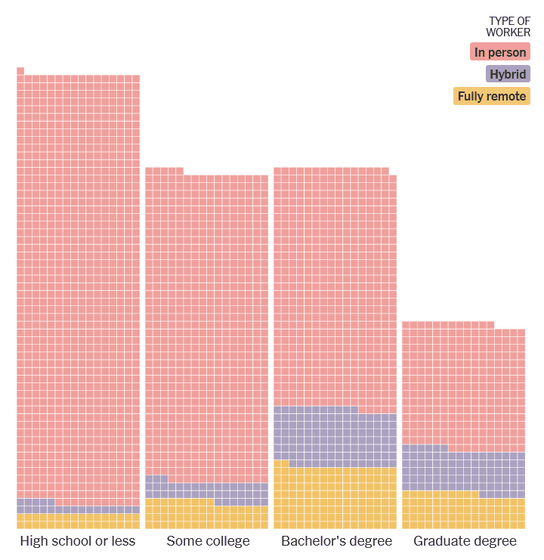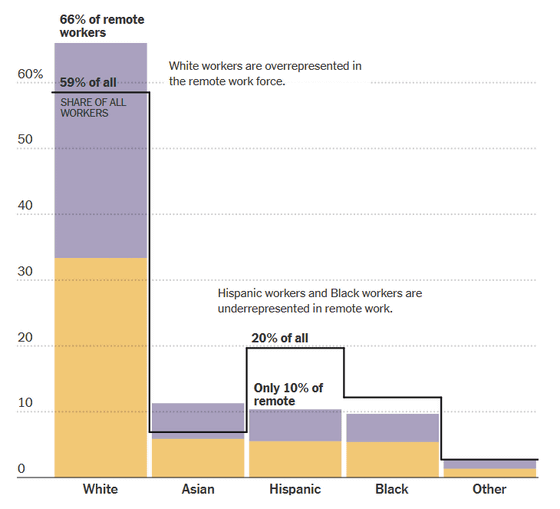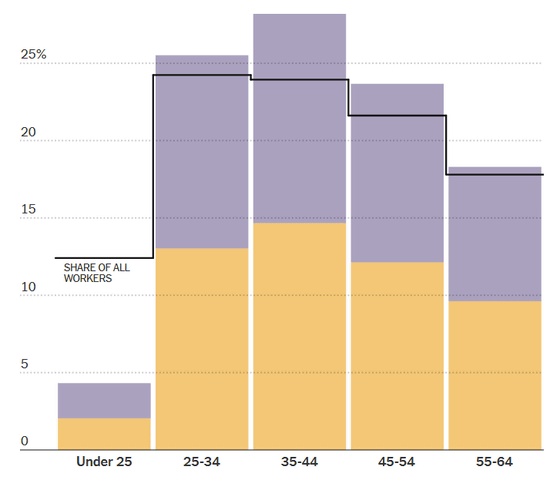Statistically analyzed data on ``who is working remotely'' reveals that remote work is a ``luxury for highly educated people''

The New York Times has released statistical data analyzing remote work, which has become popular worldwide due to the new coronavirus pandemic, and hybrid work, which is a 50-50 split between remote work and on-site work.
Work From Home Data Shows Who's Fully Remote, Hybrid and in Person - The New York Times
Since the start of the coronavirus pandemic in 2020, many workers have transitioned to remote work. Many companies promoted remote work during the pandemic, but since the coronavirus outbreak subsided, hybrid work has been adopted, where people work remotely from home several days a week and at the office several days a week. It's starting to happen.

Still, only about one in 10 employees in the United States work in a hybrid manner, and a similar percentage of workers work completely remotely. According to statistical data from the U.S. government, workers working in hybrid or remote work tend to have higher educational backgrounds and are more likely to be white or Asian.
In 2023, the total number of workers in the United States between the ages of 18 and 64 was approximately 143 million. Approximately 80% of these people work in the usual way, that is, go to the workplace and work, the remaining 10% seem to work hybrid work, and another 10% work remotely.
The classification of all workers by educational background is as follows. The number of workers in 'High school or less' is the largest, and the number of workers in 'Some college' and 'Bachelor's degree' is similar, but higher. More highly educated workers with a bachelor's degree are working in hybrid work (gray) or remote work (orange). Graduate degree workers are the least numerous and most likely to work hybrid or remote. That's why the New York Times described remote work as a 'luxury for the highly educated.'

The New York Times says, ``The coronavirus pandemic has exposed the inequalities of the American economy.While many white-collar workers can work safely from home, low-income Workers have often had to continue doing in-person work even when health risks are highest, and now that the public health emergency is over, these industry disparities - who can work remotely 'There is a growing disparity between people who benefit from work and who does not.'
Workers working remotely and hybrid work are classified by race/ethnicity as follows. A whopping 66% of remote and hybrid workers are white, followed by Asian, Hispanic, Black, and other.

Furthermore, since there are a large number of Hispanic and black workers in the United States, relatively speaking, the proportion of Asians working remotely and in hybrid work is high. According to the New York Times, 'White and Asian workers are more likely to have the opportunity to work part or all of their time remotely because they are more likely to work in an office. Workers often work in jobs that require face-to-face contact, such as food service, construction, retail, and health care.'
The graph below categorizes the age groups of workers working in remote work and hybrid work. The percentage of workers under the age of 25 working remotely or hybrid work is very low at less than 5%, but for other age groups, 25% are 25-34 years old, 27% are 35-44 years old, and 45% are under 25 years old. - Approximately 23% are aged 54 and 18% are aged 55 to 64.

One of the reasons why there are so few workers under the age of 25 working remotely and hybridly is because the percentage of college graduates in the United States is extremely low. Additionally, many young people are working in jobs that do not allow remote work, such as food service. Additionally, the New York Times points out that young workers in their 20s are more likely to be working full-time in an office than their older colleagues, even if they have a college degree. As one of the reasons why young office workers are unable to work remotely, the New York Times pointed out, ``The relatively small number of young workers with children at home may also be one reason why remote work is not prioritized.'' .
By gender, women seem to be more likely to work remotely than men. This seems to be partly due to the fact that many women are university graduates and are employed in professional jobs where flexible working arrangements are the norm. Even without a college degree, women often work in desk jobs such as clerical jobs or customer support, whereas men tend to work in jobs that can only be done face-to-face, such as construction or manufacturing. This may be the reason why there are many cases of working.
When looking at people with a university degree or above, the proportion of men and women working remotely is almost the same, with men slightly more likely to work remotely than women. Among workers working remotely or hybrid, the biggest winners are parents with children, and the spread of remote work has made it possible to balance work and childcare. It should be noted that mothers, not fathers, are most likely to take advantage of the flexibility of remote work, and mothers with young children are more likely to work remotely than women without children or mothers with older children. .

It has also been shown that workers with disabilities prefer remote work, as commuting is a very energy-draining activity for many. In fact, workers with disabilities are 22% more likely to work remotely than their non-disabled peers, and are only slightly more likely to work in a hybrid manner. It has also been found that workers with mobility disabilities, such as wheelchair users, are more likely to have the opportunity to work completely from home.
Related Posts:
in Note, Posted by logu_ii







